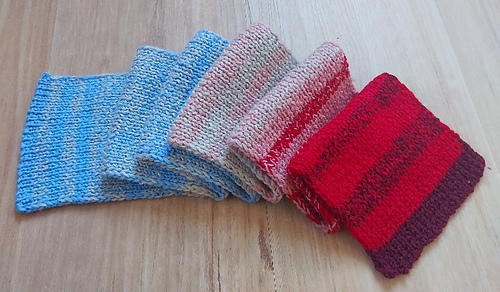patterns >  Craftivists Unite
Craftivists Unite
> Marled Global Climate scarf









Marled Global Climate scarf
This is a simple k1 p1 rib scarf to display 100+ years (1920-2025), with 4 rows/year, of global temperature variance from a 50 year long term average temperature.
The knitting is very easy and full colour charts are provided. Instructions are given for global temperatures although temperatures for other geographic regions could also be used.
If worn frequently these scarves spread the message of #ClimateActionNow and remind everyone to limit their energy usage for the sake of our planet. At around AUD20 per scarf, using BWM 4ply wool, they make a great conversation-starter for those willing to share their concern for the climate.
Materials
This scarf is a variation on the Common Grace Climate scarf of 16 colours based on the data from showyourstripes.info. It has been simplified by halving the number of colour gradations and limiting them to the cold/hot, blue/red spectrum. This is achieved by choosing 6 main colours of 4ply yarn and using 2 strands of each major colour as the intermediate colour when transitioning between major colours. Using green/brown as living/dead or blue/yellow/orange/red of water/fire would also be effective.
A beige/cream/neutral shade is chosen for the long term average temperature. Then:
• Two light shades of similar colour intensity are chosen, one a cool colour and one a warm colour, representing the first deviation from the long-term temperature average.
• Two medium colours are chosen for the second deviation from the long-term temperature average (although this cool shade is only used for 3 years after 1920).
• A dark or hot, colour is needed for the third deviation to illustrate the hottest temperatures that are unprecedented and dangerous. While the global temperatures remain in this range human society is under threat of collapse from inability to recover from frequent extreme weather events and unreliable weather for food producers.
Thus:
C1: Cold colour – dark blue
C2: Cool colour – mid blue
C3: Neutral colour – cream
C4: Warm colour – red
C5: Hot colour – burgundy
C6: Hottest colour – ash
Depending on scarf size, a full 50g ball is usually needed for colours C2, and C4, C3 will need 2x50g balls for the medium size, while much smaller amounts are needed of colours C1, C5 and C6. The percent of the scarf weight of each colour for the global scarf is given in the free pattern along with alternative colourways.
Explaining what your scarf represents
The smaller the geographic area you choose, the more of the long-term average you are likely to see, and the clearer the various extreme weather events in your local history will be displayed. The larger the geographic region, the more averaging of sub-climates occurs. Thus the global scarves displays a full gradient from cold to extreme hot with the long-term average temperatures clearly displayed during 1980-1989 in the 6-colour global scarf (lower scarf in 2 scarf image ).
The global scarves also clearly shows the impact that World War 2 had on the climate (increased worldwide fossil fuel usage for transport and armament production etc.) with 1940-1941 and 1943-1945 being similar to the 1971-2000 long term average temperature, surrounded by cool years. Of concern is the likelihood (see IPCC trends chart right) that, by 2030, an even more extreme colour will be needed for the global scarf.
Note: While there may be variation in colours per year depending on what years your data source chooses for the long-term average temperature, the trend and rate of increasing is consistent: viz, #showyourstripes uses 1980-2000 for the long-term temperature average while the 2023 IPCC temperature trend graph, above, uses 1850-1900 for the long-term temperature average.
7053 projects
stashed
3757 times
- First published: May 2023
- Page created: May 6, 2023
- Last updated: May 30, 2025 …
- visits in the last 24 hours
- visitors right now




